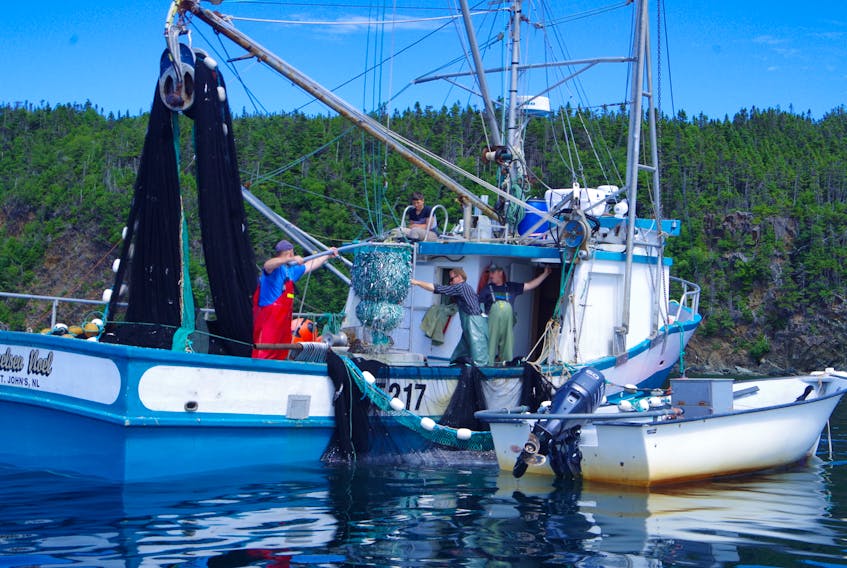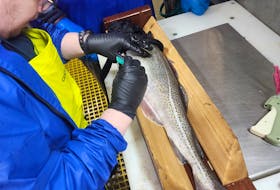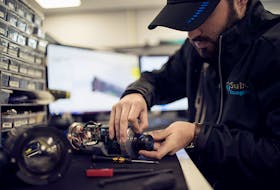ST. JOHN'S, N.L. — The picture is bleak.
The capelin stock in Newfoundland and Labrador has not had any sustained growth for 30 years, and the chances of a quick rebound are poor.
Fran Mowbray, capelin biologist with Fisheries and Oceans (DFO), wouldn’t go as far as to say the stock could become extinct.
“I don’t think we have enough evidence to say that. We are definitely concerned about the status of the stock right now. But worldwide, when forage species reach very low levels … it will take them an extremely long time to rebound.”
Environmental factors are at play, she said.
The capelin spawning cycle has changed.
Historically, the season for capelin spawning on beaches around the island was in June.
In recent years it’s been later, into July.
That’s not helping matters, said Mowbray.
The right winds and temperatures are needed to help the eggs develop into larve.
The winds and tides of June create the best conditions.
The hotter weather of July, which typically also means fewer windy days and less wave action, means the eggs dry up on the beaches, never advancing to the ocean or larve stage.
The larve that do make it off the beach and grow into capelin, she added, are maturing earlier, at two years of age. Historically capelin would mature at 3-4 years.
Scientific data shows those younger capelin come to the beaches in July, or later, at the very worst time.
And the more two-year-old capelin in the system, the more that cycle of late spawning repeats.

Capelin do spawn in the deeps as well, she added, but the late spawning cycle on the beaches is one of the environmental factors in the big picture on capelin stocks.
“Those beaches where they tend to spawn are usually northerly facing beaches and when you get southerly winds, it’s actually pushing the water away from the beach.”
The other critical point for capelin, she said, is the overwintering period.
If the capelin doesn’t get enough to eat before winter, she said, survival is tougher.
“If they aren’t chubby enough by end of fall, and they have to starve all winter and breakfast isn’t served soon enough in the spring, then you’re going to have another mass mortality,” said Mowbray.
As for whether or not scientists think the commercial fishery should be shut down, Mowbray said the decision on opening or closing fisheries lies with the minister.
Mowbray did say, however, this is the first time science has stated that “removals from all sources should be kept at the lowest possible level.”
“You can infer what you want from that. It is a statement that we haven’t made in the past because we didn’t feel the fishery was having that big of a negative impact.
“But with everything lined up against capelin, we are making that statement.”
Shutdowns
There has never been a shutdown of the capelin fishery in Newfoundland and Labrador.
But moratoriums on capelin fishing have occurred in other jurisdictions.
In fact, in zone 3N0 off the Newfoundland coast — where fisheries are managed by the Northwest Atlantic Fishing Organization (NAFO) — capelin fishing has been under a moratorium since 1993.
Prior to the collapse of the stock in 3NO, the quota had declined from a high of 200,000 metric tonnes in the 1970s, to 30,000 tonnes for 1990-92.

A NAFO report from 2014 noted other factors, besides commercial fishing, must be at play.
“Considering that the catch did not exceed TAC in the whole regulation period, the decline of the stock size observed since early 1990s, could hardly be caused by overexploitation of the stock.”
You can find the NAFO report here: https://www.nafo.int/Portals/0/PDFs/sc/2015/scr15-027.pdf
Fisheries managers in Norway and Iceland have also closed commercial capelin fisheries at various times, and sometimes for years at a stretch.
“For the past several years they (Norway) have not had a sufficient spawner biomass to support a commercial fishery and feed the ecosystem, so the capelin fishery has been shut down there for several years now,” said Mowbray.
Iceland follows similar management protocols, she said, noting that country shut down the commercial capelin fishery in 2020.
Go or no
The latest information from DFO is ramping up the debate on whether or not to allow a commercial capelin fishery this year.
Last week the World Wildlife Fund (Canada) called for closure, saying scientific data from recent years clearly shows “we are fishing a collapsed resource.
“By failing to protect these forage fish, we are failing to prioritize the health of the ecosystem, which will have long-term impacts on the biodiversity and economic opportunities of the region,” said Sigrid Kuehnemund, VP of wildlife and industry for WWF-Canada.
On Wednesday, others followed suit.
Oceana Canada called on Fisheries and Oceans Minister Bernadette Jordan to immediately pause the commercial capelin fishery.
In a news release that group noted it has been three decades since this stock collapsed in the early 1990s, and today the biomass index is still only six per cent of pre-collapse estimates.
Dr. Robert Rangeley, Science Director, Oceana Canada, said in a news release, “The fishery should be paused until the stock recovers, reference points are established, and precautionary quotas are set based on capelin’s vital role in the ecosystem.
“The onus is on Fisheries and Oceans Canada to follow best science-based practices to ensure that the fishery is doing no harm to the stock or the ecosystem it supports,” Rangely said.
Other factors?
The Fish Food and Allied Workers (FFAW-Unifor), meanwhile, continue to point to other factors that may be impacting the size of the capelin stock.
In a newss release, FFAW president Keith Sullivan said, a DFO report from 2012 estimated seals ate about 1.2 million tonnes of capelin in 2008.
“You cannot advocate for the sustainability of a healthy capelin stock by removing commercial fisheries and not taking action to control the size of the seal herd,” Sullivan said.
Mowbray said they don’t have detailed seal diet data from last year, so they could not include that data in the capelin stock assessment.
She said there should be some data available on seal diets by mid-summer, and that information will be included in next year’s report on capelin.
FFAW member Dennis Chaulk, who fishes capelin in the Bonavista Bay area, also wondered if the capelin stock is being accurately measured.
“Science can’t measure the full biomass because they only have one vessel doing an acoustic survey in the spring of the year, and it doesn’t cover the whole area,” he stated in the FFAW release.
Mowbray told the media there is a plan to collect more data on capelin.
“We have been acquiring acoustic data from those bottom trawl surveys for a number of years now,” she said, “and we just recently brought on two staff who will be working on that question.
“We will be doing some directed research in January of 2022, going out to the areas where we collected signals during the bottom trawls, so we can do some directed trawling on those areas.
“We’re hopeful that in a couple of years from now we should be able to draw information about the spawning stock biomass from that work.”
Next steps
Last year’s total allowable catch (TAC) for capelin was 24,000 metric tonnes. However, fishers landed just 16,000 tonnes, or 89 per cent of the TAC. The full quota for zone 3L was taken, but landings in 3K were less than the total allowed.
Ultimately, the decision on whether or not to allow a capelin fishery, rests with Fisheries and Oceans minister Bernadette Jordan.
Through next week members of the fishing industry, DFO scientists, academia and others will meet virtually to discuss and debate the latest assessment. From those meetings recommendations will be forwarded to DFO managers and the minister, to contemplate and made a decision for 2021.
The commercial capelin fishery in this province usually runs from late June to mid-July.
Barb Dean-Simmons is a business reporter for the SaltWire Network.
[email protected]
Twitter: @BarbDeanSimmons









